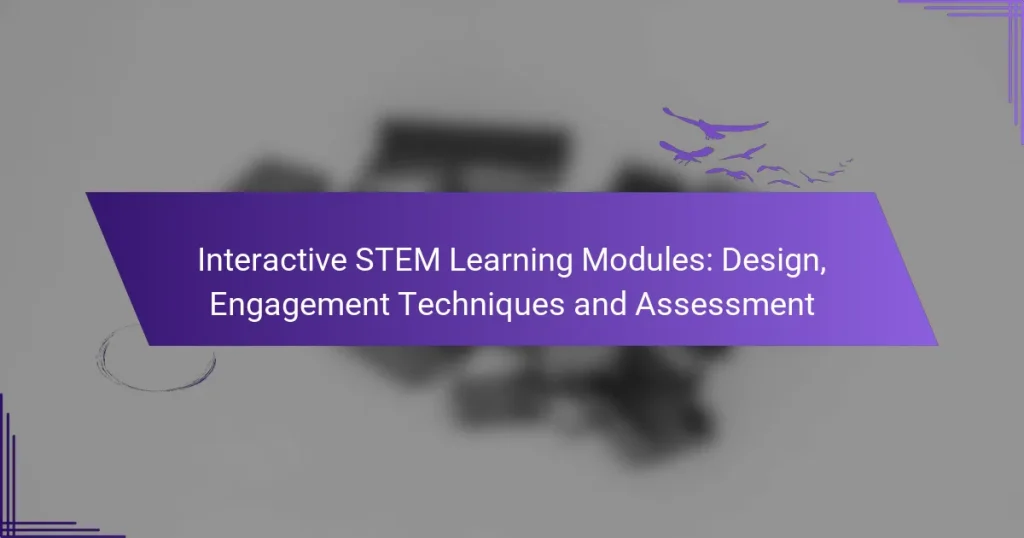Interactive STEM learning modules are designed to create engaging, hands-on experiences that enhance critical thinking and problem-solving skills. By incorporating project-based learning, multimedia, and gamification, these modules cater to diverse learners while fostering collaboration and real-world application. Effective assessment methods, such as formative assessments and digital portfolios, further ensure a comprehensive evaluation of student progress and understanding.
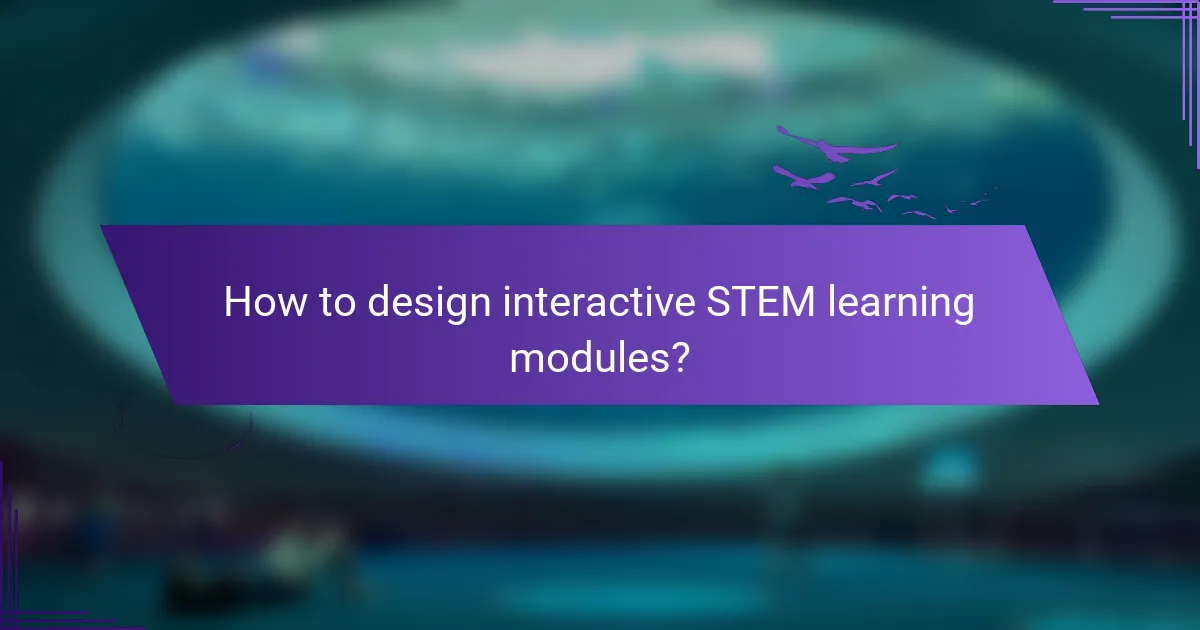
How to design interactive STEM learning modules?
Designing interactive STEM learning modules involves creating engaging and hands-on experiences that foster critical thinking and problem-solving skills. Key elements include project-based learning, multimedia integration, gamification, and ensuring accessibility for diverse learners.
Utilize project-based learning
Project-based learning (PBL) immerses students in real-world challenges, encouraging them to collaborate and apply their knowledge. This approach can enhance retention and understanding by allowing learners to explore topics deeply through practical applications.
To implement PBL effectively, define clear objectives and structure projects around relevant, authentic problems. For example, students could design a sustainable garden, integrating concepts from biology, chemistry, and environmental science.
Incorporate multimedia elements
Multimedia elements, such as videos, interactive simulations, and infographics, can significantly enhance engagement in STEM learning modules. These tools cater to various learning styles and help illustrate complex concepts more clearly.
When incorporating multimedia, ensure that it complements the learning objectives. For instance, using a simulation to demonstrate chemical reactions can provide a visual and interactive experience that reinforces theoretical knowledge.
Apply gamification techniques
Gamification involves integrating game-like elements, such as points, badges, and leaderboards, into learning experiences to motivate students. This technique can make STEM subjects more enjoyable and encourage friendly competition among learners.
To effectively apply gamification, set clear goals and provide immediate feedback. For example, a module could reward students with points for completing challenges or quizzes, fostering a sense of achievement and progress.
Ensure accessibility for all learners
Accessibility is crucial in designing interactive STEM learning modules to accommodate diverse learners, including those with disabilities. Consider various needs by providing alternative formats and ensuring that all materials are easy to navigate.
Use universal design principles, such as clear language, adjustable text sizes, and audio descriptions, to enhance accessibility. Regularly seek feedback from learners to identify areas for improvement and ensure that all students can engage with the content effectively.

What engagement techniques enhance STEM learning?
Engagement techniques that enhance STEM learning focus on interactive and collaborative methods, making the learning process more dynamic and effective. By fostering teamwork, applying real-world scenarios, and utilizing technology, educators can significantly improve student interest and retention in STEM subjects.
Use collaborative group activities
Collaborative group activities encourage students to work together, sharing ideas and solving problems collectively. This approach not only enhances communication skills but also allows learners to tackle complex concepts through peer support and diverse perspectives.
To implement this, consider structuring activities around project-based learning where groups can explore a specific STEM topic. For example, students could design a simple bridge using limited materials, promoting teamwork and critical thinking.
Implement real-world problem-solving
Real-world problem-solving connects STEM learning to practical applications, making the content more relevant and engaging. By presenting students with authentic challenges, they can apply theoretical knowledge to find solutions that impact their communities or the environment.
For instance, students might analyze local water quality issues and develop a plan to address them. This not only enhances their analytical skills but also instills a sense of responsibility and purpose in their learning.
Leverage technology tools like Kahoot!
Technology tools such as Kahoot! can significantly enhance engagement by making learning interactive and fun. These platforms allow educators to create quizzes and games that reinforce STEM concepts while providing instant feedback to students.
To effectively use Kahoot!, teachers can design quizzes that align with their curriculum, enabling students to compete in a friendly environment. This method can increase motivation and retention, as students are more likely to remember information presented in an engaging format.
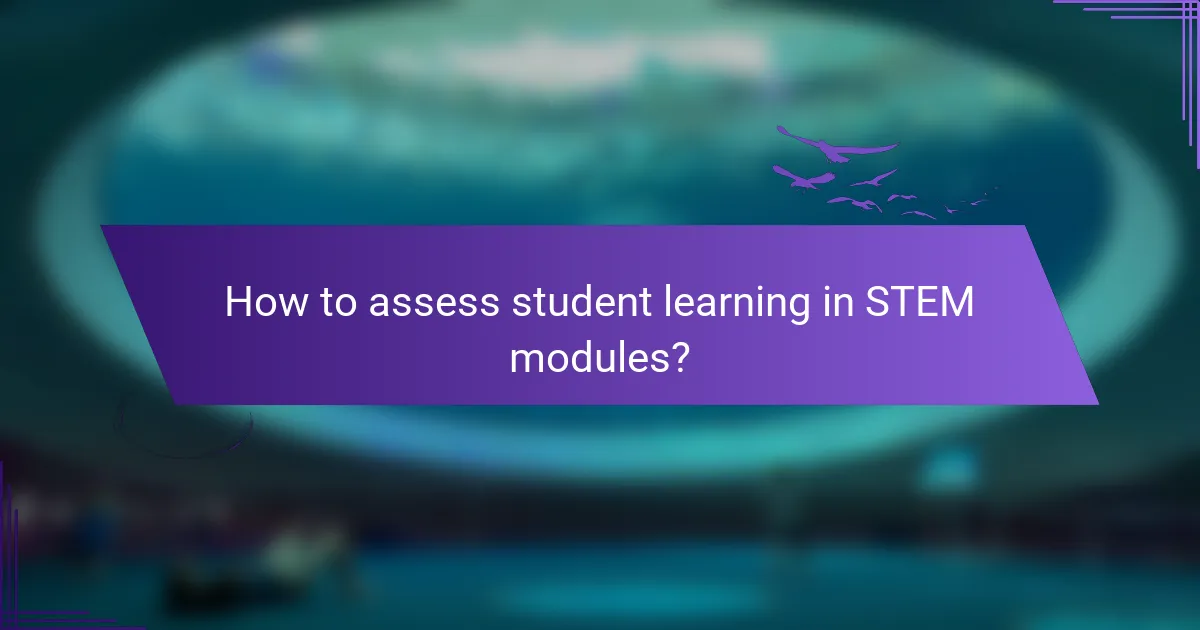
How to assess student learning in STEM modules?
Assessing student learning in STEM modules involves a combination of methods that provide insights into understanding and skills. Effective assessment strategies include formative assessments, peer reviews, and digital portfolios, each contributing to a comprehensive evaluation of student progress.
Use formative assessments
Formative assessments are ongoing evaluations that help educators gauge student understanding during the learning process. Techniques such as quizzes, polls, and interactive activities allow for real-time feedback and adjustments to teaching methods. Aim to incorporate these assessments regularly, ideally after each major topic or concept.
Consider using a mix of low-stakes quizzes and hands-on projects to measure comprehension. For example, a short quiz after a lesson can reveal areas needing reinforcement, while a project can showcase applied knowledge. Keep assessments brief to encourage participation without overwhelming students.
Implement peer review processes
Peer review processes enable students to evaluate each other’s work, fostering critical thinking and collaborative skills. This method encourages students to engage deeply with the material and provides diverse perspectives on their understanding. Establish clear guidelines and rubrics to ensure constructive feedback.
For instance, after completing a project, students can exchange their work and provide feedback based on specific criteria. This not only enhances their analytical skills but also builds a sense of community. Ensure that students are trained on how to give and receive feedback effectively to maximize the benefits of this process.
Utilize digital portfolios
Digital portfolios serve as a comprehensive collection of student work, showcasing their learning journey and achievements in STEM. They allow students to reflect on their progress and demonstrate their skills to teachers and peers. Encourage students to regularly update their portfolios with projects, assessments, and reflections.
Consider platforms that allow for multimedia submissions, such as videos, presentations, and written reports. This variety can highlight different skills and learning styles. Regularly review portfolios with students to discuss their growth and set future learning goals, ensuring that they remain engaged and motivated.
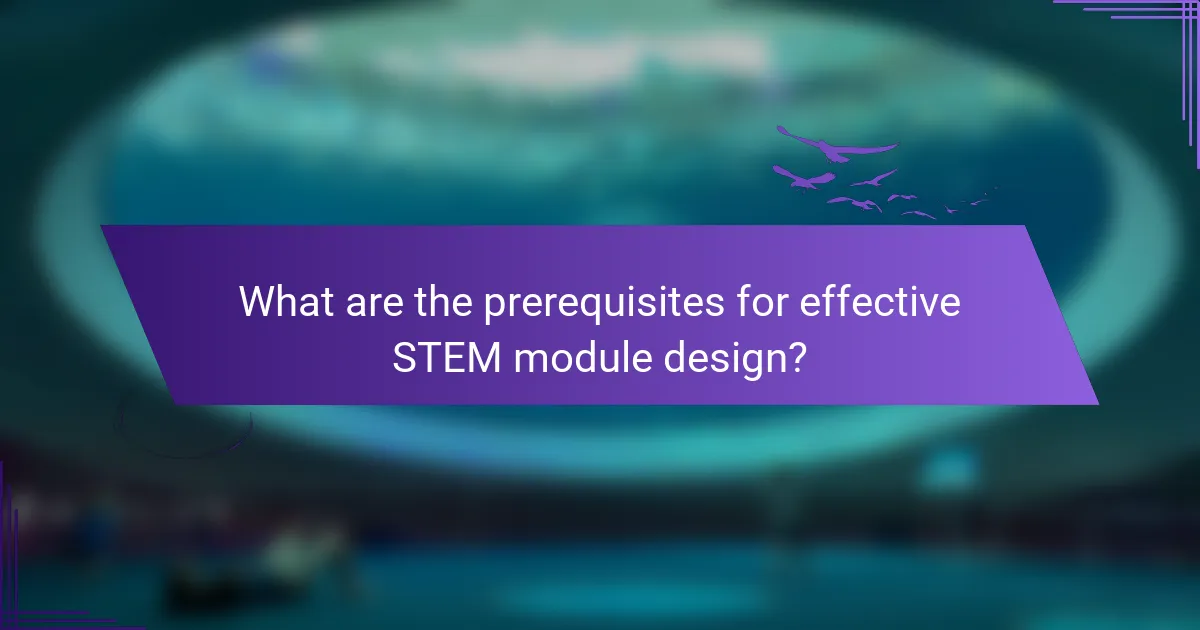
What are the prerequisites for effective STEM module design?
Effective STEM module design requires a clear understanding of educational goals and the specific needs of the learners. By focusing on these prerequisites, educators can create engaging and impactful learning experiences that foster student interest and comprehension.
Understand learning objectives
Defining clear learning objectives is essential for effective STEM module design. These objectives should outline what students are expected to know or be able to do by the end of the module, providing a roadmap for both instruction and assessment.
Consider using the SMART criteria—Specific, Measurable, Achievable, Relevant, and Time-bound—to formulate these objectives. For example, instead of a vague goal like “understand physics,” specify “apply Newton’s laws to solve basic motion problems within two weeks.” This clarity helps guide both teaching strategies and student expectations.
Identify target audience needs
Understanding the needs of the target audience is crucial for designing effective STEM modules. This involves assessing students’ prior knowledge, learning styles, and interests to tailor content that resonates with them.
Conduct surveys or informal assessments to gather insights about your learners. For instance, if a significant portion of the audience struggles with basic math, integrating foundational math concepts into the STEM module can enhance comprehension and engagement. Additionally, consider cultural and contextual factors that may influence learning preferences.
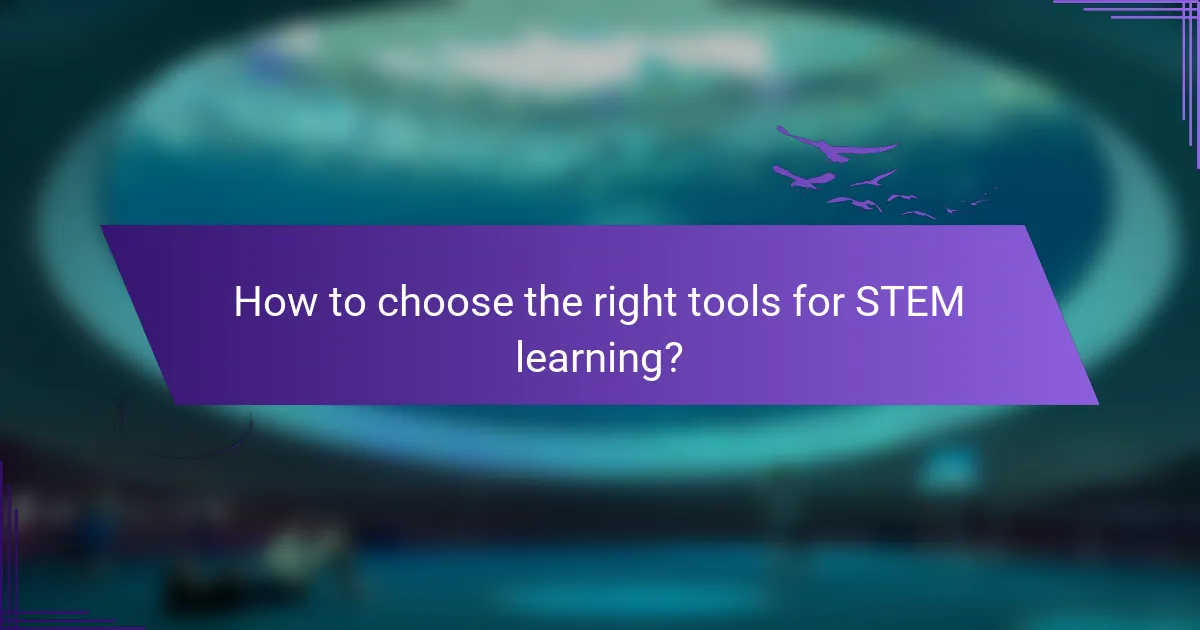
How to choose the right tools for STEM learning?
Selecting the right tools for STEM learning involves assessing the platform’s capabilities, user engagement features, and alignment with educational goals. Consider factors such as ease of use, accessibility, and the ability to integrate with existing curricula.
Evaluate platforms like Google Classroom
Google Classroom is a widely used platform that facilitates the management of assignments, communication, and collaboration among students and teachers. When evaluating it, consider its integration with other Google tools, which can enhance the learning experience through seamless access to resources.
Look for features such as assignment tracking, feedback mechanisms, and the ability to organize materials effectively. A strong point of Google Classroom is its user-friendly interface, which can reduce the learning curve for both educators and students.
However, be aware of potential limitations, such as the need for a Google account and the reliance on internet access. Ensure that the platform meets the specific needs of your educational context, including any compliance with local data privacy regulations.
Consider tools for simulations like PhET
PhET Interactive Simulations offers a range of free online simulations that cover various STEM topics, allowing students to engage in hands-on learning experiences. These simulations can enhance understanding by providing visual and interactive representations of complex concepts.
When considering PhET, evaluate the alignment of its simulations with your curriculum standards and learning objectives. The platform is particularly effective for subjects like physics, chemistry, and biology, where visualizing processes can significantly aid comprehension.
Keep in mind that while PhET is an excellent resource, it may require additional instructional support to maximize its effectiveness. Encourage students to explore simulations independently, but also provide guided activities to reinforce learning outcomes.

What are emerging trends in interactive STEM education?
Emerging trends in interactive STEM education focus on enhancing student engagement and improving learning outcomes through innovative technologies and teaching methods. These trends emphasize the integration of artificial intelligence, interdisciplinary approaches, and hands-on learning experiences.
Integration of AI in learning modules
The integration of artificial intelligence in STEM learning modules personalizes the educational experience by adapting content to individual student needs. AI tools can analyze student performance in real-time, providing tailored feedback and resources that enhance understanding and retention.
For example, platforms like DreamBox Learning and Carnegie Learning use AI algorithms to adjust math problems based on student responses, ensuring that learners are challenged at the right level. This adaptive learning approach can significantly improve engagement and mastery of complex concepts.
Focus on interdisciplinary approaches
Interdisciplinary approaches in STEM education combine knowledge from various fields, fostering a more holistic understanding of complex problems. By integrating subjects like art, technology, and environmental science, educators can create engaging projects that resonate with students’ interests and real-world applications.
For instance, a project that involves designing a sustainable garden can incorporate biology, engineering, and art, allowing students to explore multiple disciplines while solving a tangible issue. This method not only enhances critical thinking but also prepares students for collaborative work in diverse teams.
